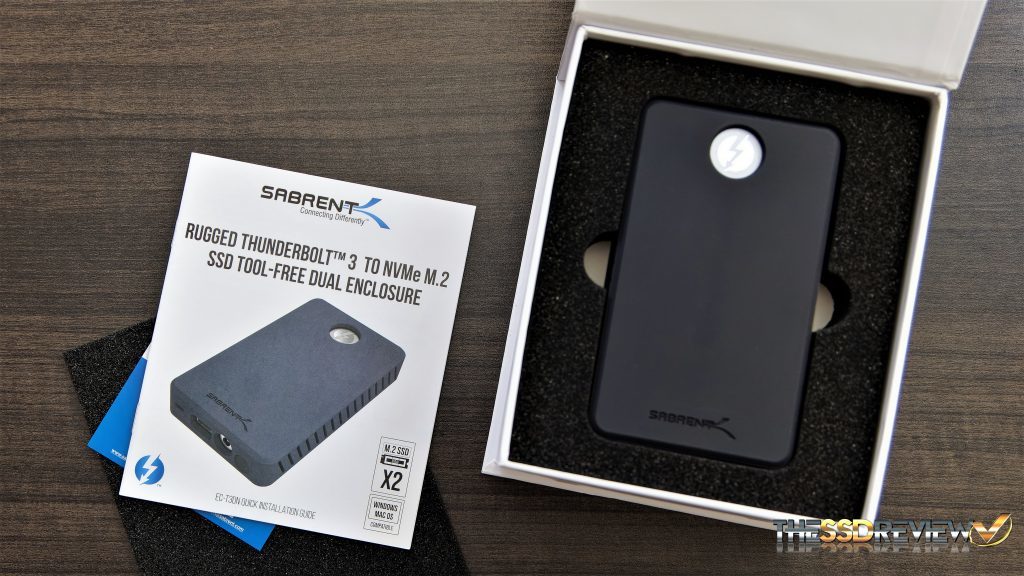On our test Bench today is the Sabrent Rugged Thunderbolt 3 to Dual NVMe M.2 SSD Tool-Free Enclosure. It is a bit different than most as it allows one to install and work with two M.2 SSDs, vice one. Unlike similar Thunderbolt 3 enclosures, the user has the ability two create and use logical drives from two SSDs, during which a maximum transfer speed of 1500MB/s can be achieved, or both SSDs can be set into a software RAID at which time the data transfer achieved is that of the full Thunderbolt 3 speed of 2.8GB/s.
Within the exterior box is the device itself, a black protective silicon casing, instruction manual as well as another box inside. This contains a rather large power adapter and plug, Thunderbolt 3 cable and thermal pads of two different thickness’. It should be noted that the power brick is actually bigger and heavier than the external device itself.
The Sabrent EC-TN3D itself is a solid matte grey two piece aluminum shell with a bottom that is easily removed.
A simple twist of the small metal handle enables the base to be removed.
At the bottom are two LEDs that display SSD activity, a Thunderbolt 3 port, DC-IN and a small rubber power switch. We found the power switch to be a bit lacking as there are power LEDs, but they are contained inside the unit. Without disk activity, there is no means of identifying whether the unit is powered on or off.
Many might consider that it would be obvious and shown on your PC screen, but in instances where the SSD has not been formatted or something is wrong with the SSD, there is no way of identifying whether it is the SSD or the unit as one cannot tell if it is on or off, without removing the base and checking the inside LEDs.

For our testing today, we are going to be utilizing two brand new Sabrent PCIe 4 Rocket 4 Plus SSDs, first alone and then in a software RAID. Yes…this might be overkill in normal circumstances.
CRYSTAL DISK BENCHMARK VER. 7.0.0 X64
Crystal Disk Benchmark is used to measure read and write performance through sampling of random data which is, for the most part, incompressible. Performance is virtually identical, regardless of data sample so we have included only that using random data samples.
LOGICAL PARTITIONS
SOFTWARE RAID
The first result is that of a single drive while the second are both in a striped RAID volume. Surprisingly, all of our results exceeded manufacturers specifications and, in fact, the Thunderbolt 3 results are just about the best we have seen yet.
The Sabrent EC-T3DN has a one-year warranty which can be extended to two years through registration. It is plug and play and can accommodate 2242, 2260 or the standard 2280 size M.2 SSDs. We have seen literature that reflects this unit as requiring no external power, however, in our testing we could not in any way use the device without it being plugged in.
This picture is a typical day of testing, today all just happens to be Sabrent. Checking Amazon, we see the EC-T3DN priced at $149.99 which is a good price considering that all one get in this device.
Check for Sabrent EC-T3DN pricing at Amazon.
 The SSD Review The Worlds Dedicated SSD Education and Review Resource |
The SSD Review The Worlds Dedicated SSD Education and Review Resource | 

Also curious about any thermal issues over time as there appears to be no cooling and a small case. How hot did this get?
Not hot whatsoever…. ,warm barely. Remember, you are only moving data at 2.8GB/s at most.
i cant understand something
thunderbolt 3 – 40Gb\s = 5GB\s
this thunderbolt 3 = thunderbolt 2 (20Gb\s = 2.5GB\s)?
Thunderbolt 3 4-lane is 40Gbps, therefore Thunderbolt 3 in 2-lane is 20Gbps. 20Gbps in this instance reaches just below 1.6GB/s.
>”20Gbps in this instance reaches just below 16GB/s.”
Where does the 16GB/s come from? Shouldn’t that be 16Gb/s as per the TB3 “Minimum PC data requirements” in the diagram linked below?
https://newsroom.intel.com/news/introducing-thunderbolt-4-universal-cable-connectivity-everyone/
1.6GB/s…sorry fixed.
Is there software RAID 1 available? What software is used to configure the RAID?
You set the RAID in Windows 10 Disk Management as you might do for any similar two or more disk solution.
Also, what’s the power rating on the power supply? Is there any hope for a dual NVME enclosure that’s powered with the 15 Watts that USB-C / TB3 put out?
So each SSD has access to only 2 PCIE lanes, so you could achieve 1.6GB/s on both SSDs at the same time or the 2.8GB/s on a raid config (using the 4 lanes), is that it?
How many Watts is this power brick? On theory it probably could be powered by a 100w USB type c port.
Where did you find it for the price of 149.99? Everywhere I look this thing is $100 dollars over priced!
That was the Amazon price when the article was posted.
What speeds can you expect running RAID1 software? THanks